Mechanistic Insights into Visible Light-Induced Direct Hydroxylation of Benzene to Phenol with Air and Water over Pt-Modified WO3 Photocatalyst
Abstract
:1. Introduction
2. Results
2.1. Preparation of Pt-Deposited Tungsten Trioxide (WO3) and Its Characterization
2.2. Photocatalytic Hydroxylation of Benzene on the Pt-WO3 under Visible-Light Irradiation
2.3. Role of H2O on the Photocatalytic Reactions
2.4. Role of O2 on the Photocatalytic Reactions
2.5. Reaction Mechanisms for Photocatalytic Hydroxylation of Benzene to Phenol
3. Materials and Methods
3.1. Materials
3.2. Photoelectrochemical Deposition of Pt Species as Co-Catalyst on the WO3
3.3. Characterizations
3.4. Photocatalytic Reactions
3.5. Electrochemical Measurements
3.6. Density Functional Theory (DFT) Calculation
4. Conclusions
Supplementary Materials
Author Contributions
Funding
Conflicts of Interest
References
- Wang, Y.; Suzuki, H.; Xie, J.; Tomita, O.; Martin, D.J.; Higashi, M.; Kong, D.R.; Abe, R.; Tang, J. Mimicking natural photosynthesis: Solar to renewable H2 fuel synthesis by Z-scheme water splitting systems. Chem. Rev. 2018, 118, 5201–5241. [Google Scholar] [CrossRef] [PubMed] [Green Version]
- Schneider, J.; Matsuoka, M.; Takeuchi, M.; Zhang, J.; Horiuchi, Y.; Anpo, M.; Bahnemann, D.W. Understanding TiO2 photocatalysis: Mechanisms and materials. Chem. Rev. 2014, 114, 9919–9986. [Google Scholar] [CrossRef] [PubMed]
- Ma, Y.; Wang, X.; Jia, Y.; Chen, X.; Han, H.; Li, C. Titanium dioxide-based nanomaterials for photocatalytic fuel generations. Chem. Rev. 2014, 114, 9987–10043. [Google Scholar] [CrossRef] [PubMed]
- Kou, J.; Lu, C.; Wang, J.; Chen, Y.; Xu, Z.; Varma, R.S. Selectivity enhancement in heterogeneous photocatalytic transformations. Chem. Rev. 2017, 117, 1445–1514. [Google Scholar] [CrossRef] [PubMed] [Green Version]
- Yamashita, H.; Mori, K.; Kuwahara, Y.; Kamegawa, T.; Wen, M.; Verma, P.; Che, M. Single-site and nano-confined photocatalysts designed in porous materials for environmental uses and solar fuels. Chem. Soc. Rev. 2018, 47, 8072–8096. [Google Scholar] [CrossRef]
- Higashimoto, S. Titanium dioxide-based visible-light sensitive photocatalysis: Mechanistic insight and applications. Catalysts 2019, 9, 201. [Google Scholar] [CrossRef] [Green Version]
- Asahi, R.; Morikawa, T.; Irie, H.; Ohwaki, T. Nitrogen-doped titanium dioxide as visible light-sensitive photocatalyst: Designs, developments, and prospects. Chem. Rev. 2014, 114, 9824–9852. [Google Scholar] [CrossRef]
- Abe, R.; Takami, H.; Murakami, N.; Ohtani, B. Pristine simple oxides as visible light driven photocatalysts: Highly efficient decomposition of organic compounds over platinum-loaded tungsten oxide. J. Am. Chem. Soc. 2008, 130, 7780–7781. [Google Scholar] [CrossRef]
- Arai, T.; Horiguchi, M.; Yanagida, M.; Gunji, T.; Sugihara, H.; Sayama, K. Reaction mechanism and activity of WO3-catalyzed photodegradation of organic substances promoted by a CuO cocatalyst. J. Phys. Chem. C 2009, 113, 6602–6609. [Google Scholar] [CrossRef]
- Arai, T.; Horiguchi, M.; Yanagida, M.; Gunji, T.; Sugihara, H.; Sayama, K. Complete oxidation of acetaldehyde and toluene over a Pd/WO3 photocatalyst under fluorescent- or visible-light irradiation. Chem. Commun. 2008, 43, 5565–5567. [Google Scholar] [CrossRef]
- Tomita, O.; Sugimoto, T.; Sako, K.; Hayakawa, S.; Katagiri, K.; Inumaru, K. Enhanced photocatalytic activity of Pt/WO3 photocatalyst combined with TiO2 nanoparticles by polyelectrolyte-mediated electrostatic adsorption. Catal. Sci. Technol. 2015, 5, 1163–1168. [Google Scholar]
- Higashimoto, S.; Katsuura, K.; Yamamoto, M.; Tahakashi, M. Photocatalytic activity for decomposition of volatile organic compound on Pt-WO3 enhanced by simple physical mixing with TiO2. Catal. Commun. 2020, 133, 105831. [Google Scholar] [CrossRef]
- Higashimoto, S.; Ushiroda, Y.; Azuma, M. Electrochemically assisted photocatalysis of hybrid WO3/TiO2 films: Effect of the WO3 structures on charge separation behavior. Top. Catal. 2008, 47, 148–154. [Google Scholar] [CrossRef]
- Tomita, O.; Otsubo, T.; Higashi, M.; Ohtani, B.; Abe, R. Partial oxidation of alcohols on visible-light-responsive WO3 photocatalysts loaded with palladium oxide cocatalyst. ACS Catal. 2016, 6, 1134–1144. [Google Scholar] [CrossRef]
- Niwa, S.; Eswaramoorthy, M.; Nair, J.; Raj, A.; Ito, N.; Shoji, H.; Nanba, T.; Mizukami, F. A one-step conversion of benzene to phenol with a palladium membrane. Science 2002, 295, 105–107. [Google Scholar] [CrossRef]
- Tanev, P.T.; Chibwe, M.; Pinnavaia, T.J. Titanium-containing mesoporous molecular sieves for catalytic oxidation of aromatic compounds. Nature 1994, 368, 321–323. [Google Scholar] [CrossRef]
- Chen, J.; Gao, S.; Xu, J. Direct hydroxylation of benzene to phenol over a new vanadium-substituted phosphomolybdate as a solid catalyst. Catal. Commun. 2008, 9, 728–733. [Google Scholar] [CrossRef]
- Ohkubo, K.; Kobayashi, T.; Fukuzumi, S. Direct oxygenation of benzene to phenol using quinolinium ions as homogeneous photocatalysts. Angew. Chem. Int. Ed. 2011, 50, 8652–8655. [Google Scholar] [CrossRef]
- Fukuzumi, S.; Ohkubo, K. One step selective hydroxylation of benzene to phenol. Asian J. Org. Chem. 2015, 4, 836–845. [Google Scholar] [CrossRef]
- Han, J.W.; Jung, J.; Lee, Y.M.; Nam, W.; Fukuzumi, S. Photocatalytic oxidation of benzene to phenol using dioxygen as an oxygen source and water as an electron source in the presence of a cobalt catalyst. Chem. Sci. 2017, 8, 7119–7125. [Google Scholar] [CrossRef] [Green Version]
- Fukuzumi, S.; Lee, Y.M.; Nam, W. Photocatalytic oxygenation reactions using water and dioxygen. ChemSusChem 2019, 12, 3931–3940. [Google Scholar] [CrossRef] [PubMed]
- Yoshida, H.; Yuzawa, H.; Aoki, M.; Otake, K.; Itoh, H.; Hattori, T. Photocatalytic hydroxylation of aromatic ring by using water as an oxidant. Chem. Commun. 2008, 38, 4634–4636. [Google Scholar] [CrossRef] [PubMed]
- Bui, T.D.; Kimura, A.; Ikeda, S.; Matsumura, M. Determination of oxygen sources for oxidation of benzene on TiO2 photocatalysts in aqueous solutions containing molecular oxygen. J. Am. Chem. Soc. 2010, 132, 8453–8458. [Google Scholar] [CrossRef] [PubMed]
- Ide, Y.; Matsuoka, M.; Ogawa, M. Efficient visible-light-induced photocatalytic activity on gold-nanoparticle-supported layered titanate. J. Am. Chem. Soc. 2010, 47, 16762–16764. [Google Scholar] [CrossRef]
- Ide, Y.; Torii, M.; Sano, T. Layered silicate as an excellent partner of a TiO2 photocatalyst for efficient and selective green fine-chemical synthesis. J. Am. Chem. Soc. 2013, 135, 11784–11786. [Google Scholar] [CrossRef]
- Zheng, Z.; Huang, B.; Qin, X.; Zhang, X.; Dai, Y.; Whangbo, M.-H. Facile in situ synthesis of visible-light plasmonic photocatalysts M@TiO2 (M = Au, Pt, Ag) and evaluation of their photocatalytic oxidation of benzene to phenol. J. Mater. Chem. 2011, 21, 9079–9087. [Google Scholar] [CrossRef]
- Goto, T.; Ogawa, M. Efficient photocatalytic oxidation of benzene to phenol by metal complex-clay/TiO2 hybrid photocatalyst. RSC Adv. 2016, 6, 23794–23797. [Google Scholar] [CrossRef]
- Tomita, O.; Abe, R.; Ohtani, B. Direct synthesis of phenol from benzene over platinum-loaded tungsten(VI) oxide photocatalysts with water and molecular oxygen. Chem. Lett. 2011, 40, 1405–1407. [Google Scholar] [CrossRef] [Green Version]
- Tomita, O.; Ohtani, B.; Abe, R. Highly selective phenol production from benzene on a platinum-loaded tungsten oxide photocatalyst with water and molecular oxygen: Selective oxidation of water by holes for generating hydroxyl radical as the predominant source of the hydroxyl group. Catal. Sci. Technol. 2014, 4, 3850–3860. [Google Scholar] [CrossRef] [Green Version]
- Chen, C.W.; Tano, D.; Akashi, M. Synthesis of platinum colloids sterically stabilized by poly(N-vinylformamide) or poly(N-vinylalkylamide) and their stability towards salt. Colloid Polym. Sci. 1999, 277, 488–493. [Google Scholar] [CrossRef]
- Arabatzis, I.M.; Stergiopoulos, T.; Andreeva, D. Characterization and photocatalytic activity of Au/TiO2 thin films for azo-dye degradation. J. Catal. 2003, 220, 127–135. [Google Scholar] [CrossRef]
- Buchachenko, A.L.; Dubinina, E.O. Photo-oxidation of water by molecular oxygen: Isotope exchange and isotope effects. J. Phys. Chem. A 2011, 115, 3196–3200. [Google Scholar] [CrossRef] [PubMed]
- Pourbaix, M. Atlas of Electrochemical Equilibria in Aqueous Solutions; Pergamon Press Ltd.: London, UK, 1966. [Google Scholar]
- Panchenko, A.; Koper, M.T.M.; Shunbina, T.E.; Mitchell, S.J.; Roduner, E. Ab Initio calculation of intermediates of oxygen reduction on low-index platinum surfaces. J. Electrochem. Soc. 2004, 151, A2016–A2027. [Google Scholar] [CrossRef] [Green Version]
- Frisch, M.J.; Trucks, G.W.; Schlegel, H.B.; Scuseria, G.E.; Robb, M.A.; Cheeseman, J.R.; Scalmani, G.; Barone, V.; Mennucci, B.; Petersson, G.A.; et al. Gaussian 09; Revision D.01; Gaussian, Inc.: Wallingford, CT, USA, 2013. [Google Scholar]
- Becke, A.D. A new mixing of Hartree–Fock and local density-functional theories. J. Chem. Phys. 1993, 98, 5648–5652. [Google Scholar] [CrossRef] [Green Version]
- Hay, P.J.; Wadt, W.R. Ab initio effective core potentials for molecular calculations. Potentials for the transition metal atoms Sc to Hg. J. Chem. Phys. 1985, 82, 270–283. [Google Scholar] [CrossRef]
- Dunning, T.H.; Hay, P.J.; Schaefer, H.F. Modern Theoretical Chemistry; Schaefer, H.F., III, Ed.; Plenum Press: New York, NY, USA, 1976; Volume 3, pp. 1–28. [Google Scholar]
- Fukui, K.; Kato, S.; Fujimoto, H. Constituent analysis of the potential gradient along a reaction coordinate. Method and an application to methane + tritium reaction. J. Am. Chem. Soc. 1975, 97, 1–7. [Google Scholar] [CrossRef]
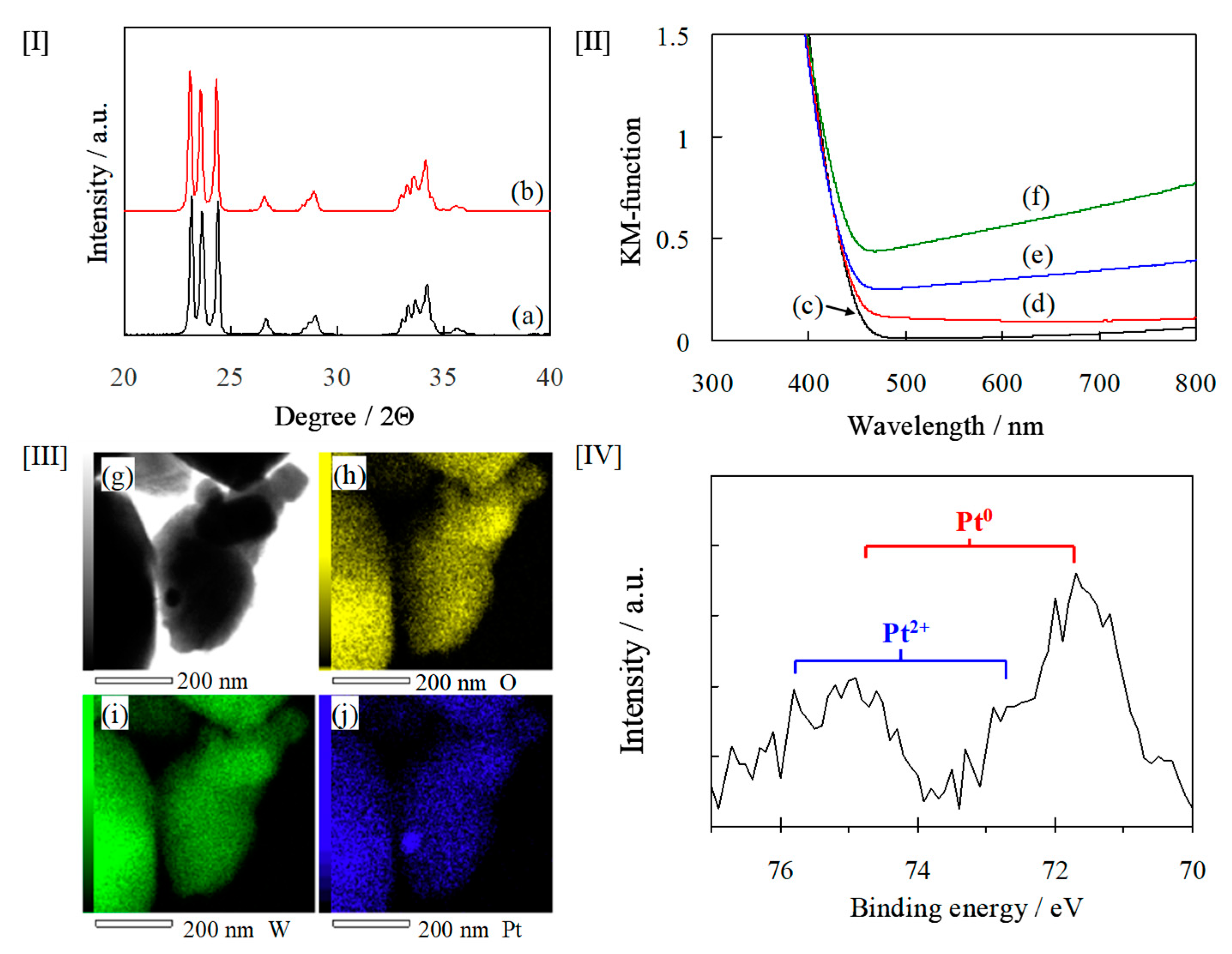
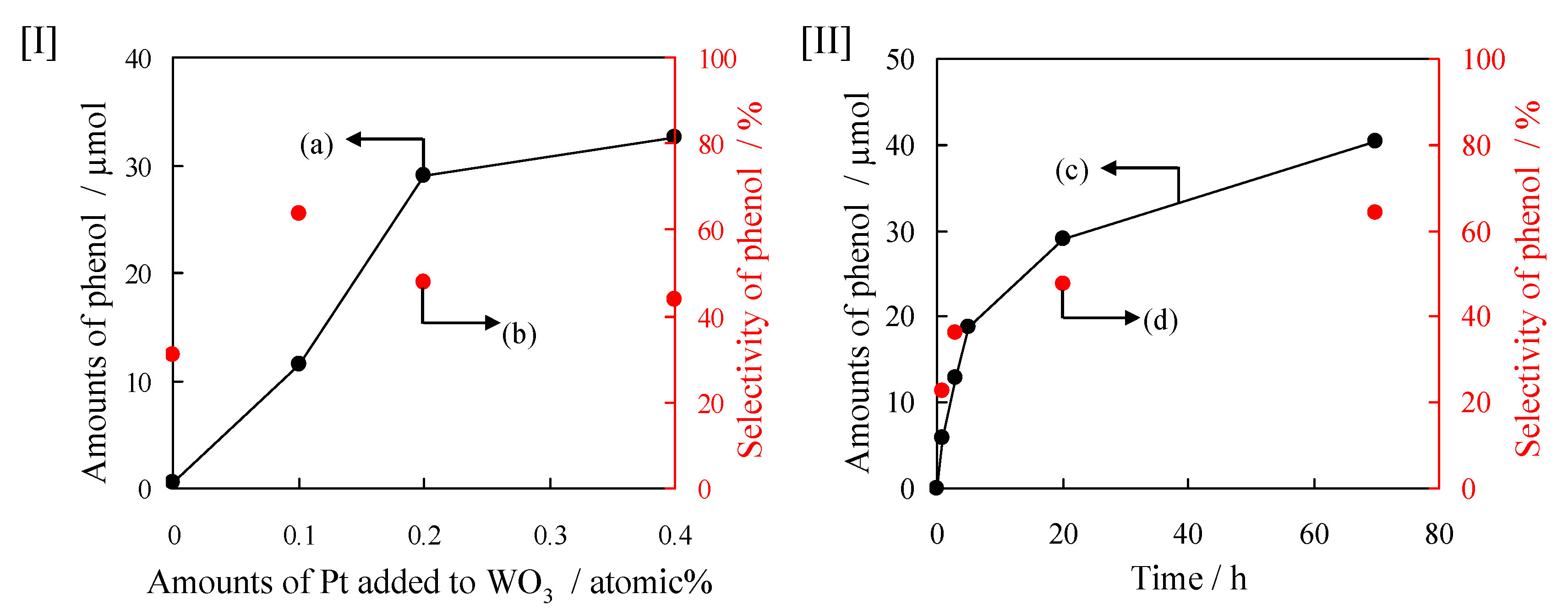
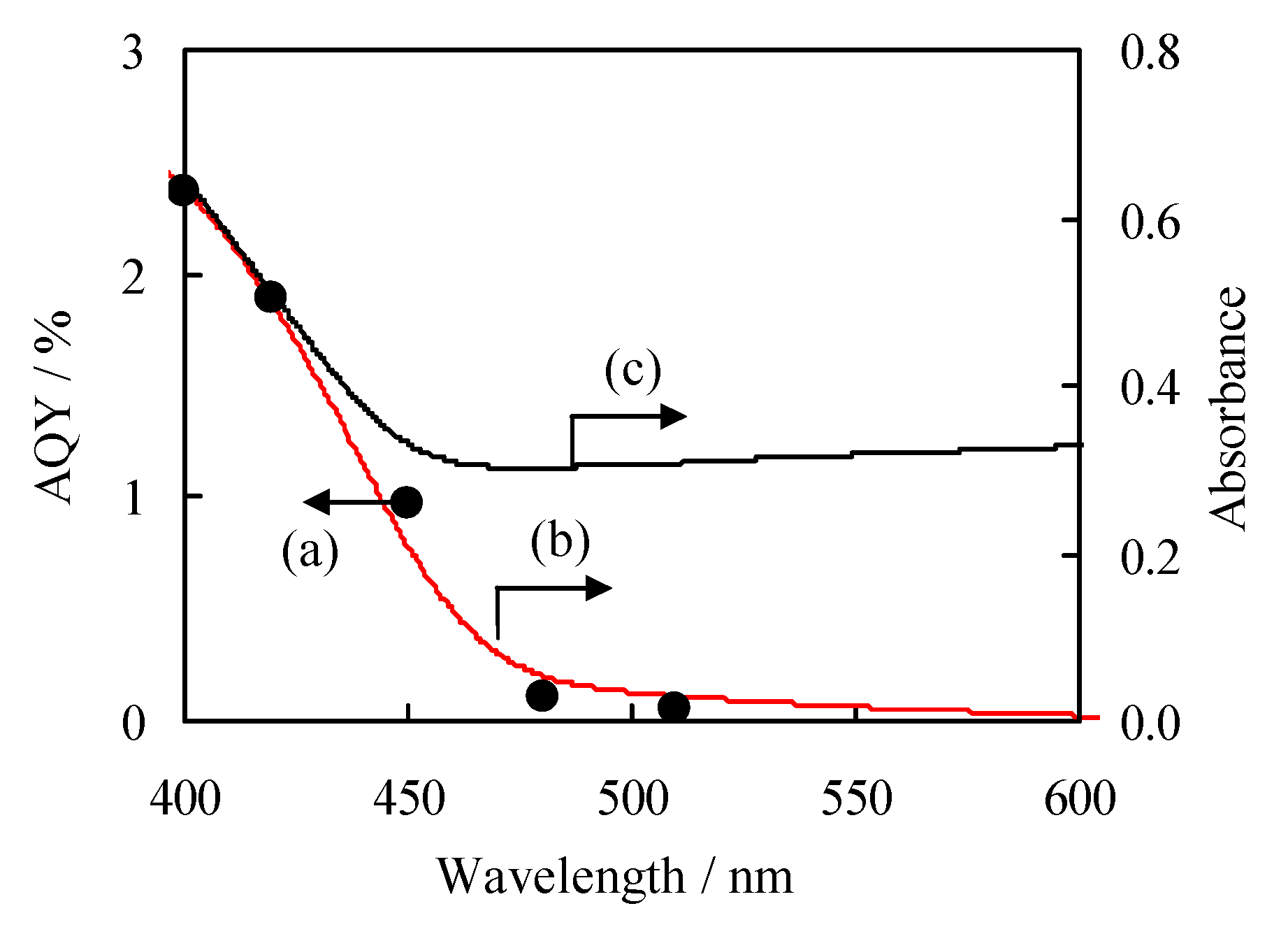
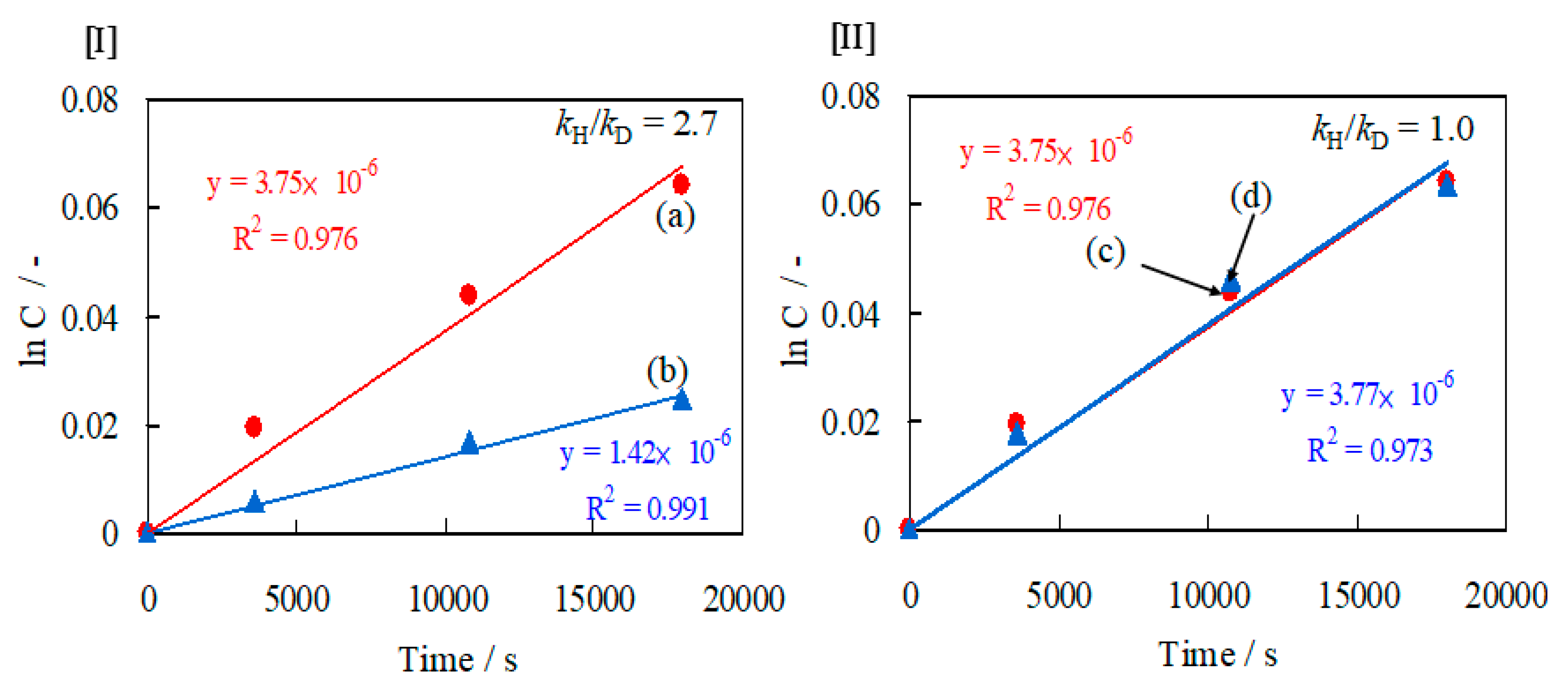
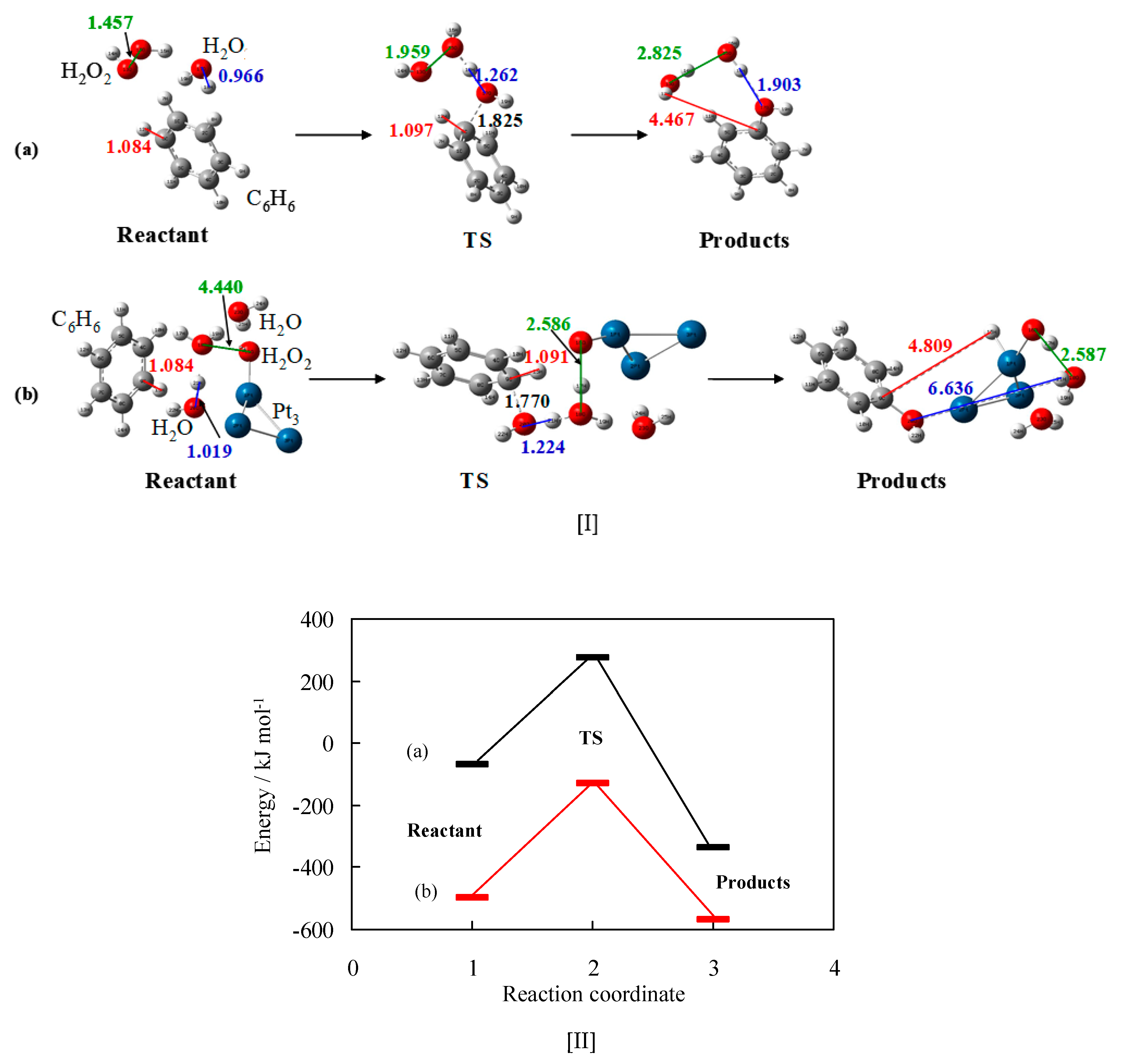
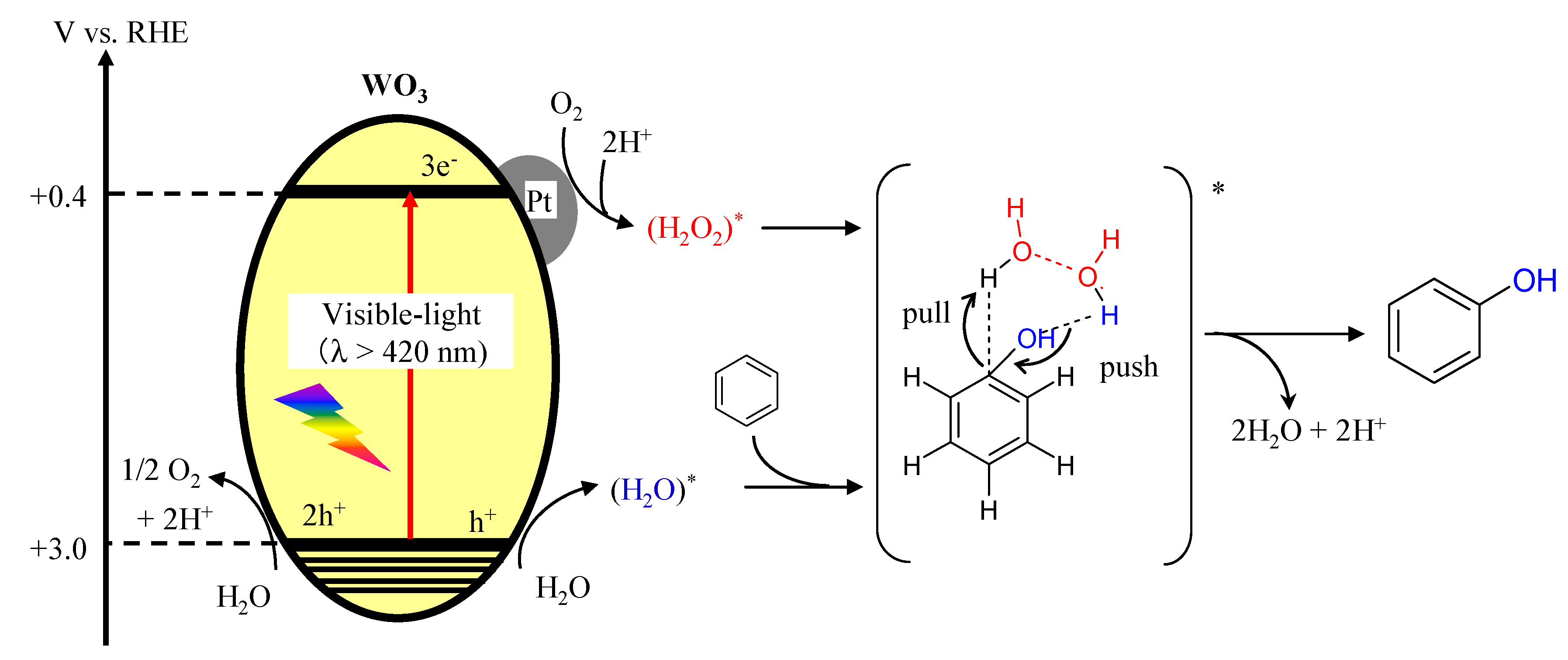
| Entry | Products/µmol | 18O/16O 1 Ratios in Phenol/% | ||||||
|---|---|---|---|---|---|---|---|---|
| PH | RE | BQ | CA | HQ | PL | PG | ||
| 1 | 22.0 | 1.4 | 0.01 | 4.3 | 0.1 | 3.4 | 1.9 | 9.9 |
| 2 | 18.0 | 0.4 | 0.03 | 5.9 | 1.3 | 5.5 | 1.7 | 9.1 |
| Reaction Condition | Products/µmol | Selectivity of PH/% | ||||||
|---|---|---|---|---|---|---|---|---|
| PH | RE | p-BQ | CA | HQ | PL | PG | ||
| Visible light/air | 29.0 | 1.2 | 0.2 | 18.3 | 0.3 | 19.0 | 2.4 | 41.0 |
| Visible light/N2 (1) | 0 | 0 | 0 | 0 | 0 | 0 | 0 | - |
| UV light/N2 (1) | 1.1 | 0.5 | 0.5 | 0.6 | 0.2 | 6.8 | 0.06 | 11.7 |
| TBA Added/μmol | Products/µmol | Selectivity of PH/% | ||||||
|---|---|---|---|---|---|---|---|---|
| PH | RE | BQ | CA | HQ | PL | PG | ||
| 0 | 29.0 | 1.2 | 0.19 | 18.3 | 0.34 | 19 | 2.4 | 41.0 |
| 50 | 29.2 | 1.39 | 0.25 | 13.3 | 0.27 | 7.9 | 5.0 | 51.0 |
© 2020 by the authors. Licensee MDPI, Basel, Switzerland. This article is an open access article distributed under the terms and conditions of the Creative Commons Attribution (CC BY) license (http://creativecommons.org/licenses/by/4.0/).
Share and Cite
Kurikawa, Y.; Togo, M.; Murata, M.; Matsuda, Y.; Sakata, Y.; Kobayashi, H.; Higashimoto, S. Mechanistic Insights into Visible Light-Induced Direct Hydroxylation of Benzene to Phenol with Air and Water over Pt-Modified WO3 Photocatalyst. Catalysts 2020, 10, 557. https://doi.org/10.3390/catal10050557
Kurikawa Y, Togo M, Murata M, Matsuda Y, Sakata Y, Kobayashi H, Higashimoto S. Mechanistic Insights into Visible Light-Induced Direct Hydroxylation of Benzene to Phenol with Air and Water over Pt-Modified WO3 Photocatalyst. Catalysts. 2020; 10(5):557. https://doi.org/10.3390/catal10050557
Chicago/Turabian StyleKurikawa, Yuya, Masahiro Togo, Michihisa Murata, Yasuaki Matsuda, Yoshihisa Sakata, Hisayoshi Kobayashi, and Shinya Higashimoto. 2020. "Mechanistic Insights into Visible Light-Induced Direct Hydroxylation of Benzene to Phenol with Air and Water over Pt-Modified WO3 Photocatalyst" Catalysts 10, no. 5: 557. https://doi.org/10.3390/catal10050557







